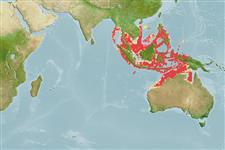>
Eupercaria/misc (Various families in series Eupercaria) >
Nemipteridae (Threadfin breams, Whiptail breams)
Etymology: Nemipterus: Greek, nema, -atos = filament + Greek, pteron = wing, fin (Ref. 45335).
More on author: Bleeker.
Environment: milieu / climate zone / depth range / distribution range
Ecología
marino demersal; no migratorio; rango de profundidad 50 - 200 m (Ref. 9785). Tropical; 17°N - 21°S, 92°E - 140°E (Ref. 3810)
Western Pacific: including the Philippines, Gulf of Thailand, Strait of Malacca, Indonesia and northern Australia. Nemipterus bleekeri has been misapplied to this species by some authors.
Length at first maturity / Tamaño / Peso / Age
Maturity: Lm ?, range 11 - ? cm
Max length : 21.0 cm SL macho / no sexado; (Ref. 3810); common length : 17.0 cm SL macho / no sexado; (Ref. 3810)
Espinas dorsales (total) : 10; Radios blandos dorsales (total) : 9; Espinas anales: 3; Radios blandos anales: 7. Suborbital spine absent. Preopercle with 3 transverse scale rows. Pectoral fins long, reaching to beyond level of anus. Pelvic fins moderately long, reaching to between just short of and just beyond level of anus. A line drawn up from posterior edge of suborbital reaching the dorsal profile at about 2 to 7 scale rows before origin of dorsal fin. Upper lobe of caudal fin falcate, tipped with bright yellow. Axillary scale present. Color: Upper body pinkish mauve, silvery white below. Yellow teardrop-shaped bar beneath eye, extending obliquely halfway to suborbital.
Occurs on mud or sand bottoms in depths greater than 50 m. There is no major fishery for this species (Ref. 3810, 125700).
Life cycle and mating behavior
Madurez | Reproducción | Puesta | Huevos | Fecundidad | Larva
Males mature at a smaller size than females (Ref. 125700).
Russell, B.C., 1990. FAO Species Catalogue. Vol. 12. Nemipterid fishes of the world. (Threadfin breams, whiptail breams, monocle breams, dwarf monocle breams, and coral breams). Family Nemipteridae. An annotated and illustrated catalogue of nemipterid species known to date. FAO Fish. Synop. 125(12):149p. Rome: FAO. (Ref. 3810)
IUCN Red List Status (Ref. 130435: Version 2024-1)
Threat to humans
Harmless
Human uses
Pesquerías: escaso valor comercial
Herramientas
Special reports
Download XML
Fuentes de Internet
Estimates based on models
Preferred temperature (Ref.
123201): 20.6 - 27.9, mean 25.3 °C (based on 293 cells).
Phylogenetic diversity index (Ref.
82804): PD
50 = 0.5000 [Uniqueness, from 0.5 = low to 2.0 = high].
Bayesian length-weight: a=0.01514 (0.00873 - 0.02625), b=3.00 (2.86 - 3.14), in cm total length, based on LWR estimates for this species & Genus-body shape (Ref.
93245).
Nivel trófico (Ref.
69278): 3.8 ±0.5 se; based on size and trophs of closest relatives
Resiliencia (Ref.
120179): Alto, población duplicada en un tiempo mínimo inferior a 15 meses (Preliminary K or Fecundity.).
Fishing Vulnerability (Ref.
59153): Low vulnerability (16 of 100).
